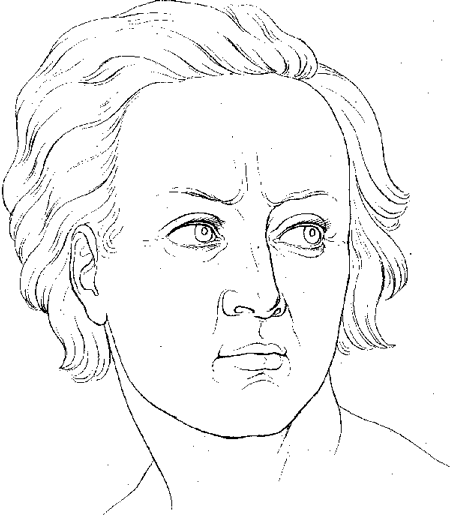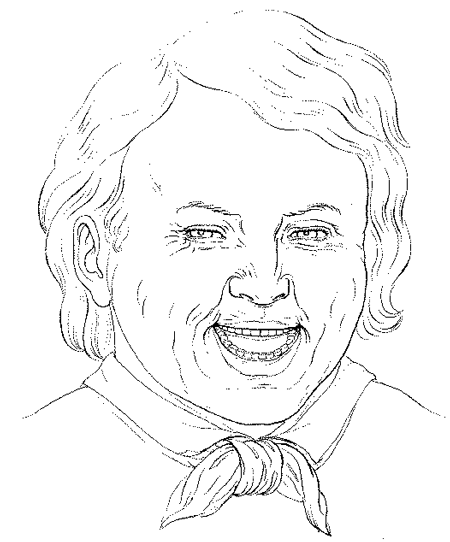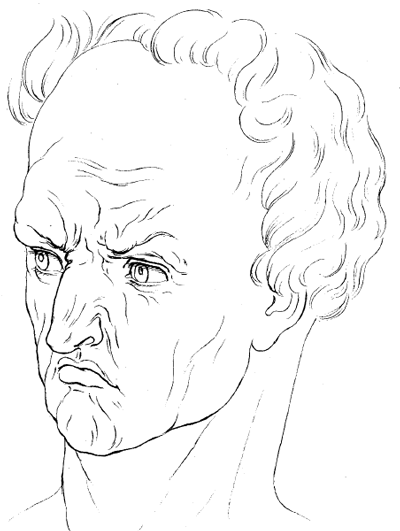
THE ACTION OF THE MUSCLES IN THE EXPRESSION OF THE PASSIONS.
Were no injurious influences to our physical organization to be guarded against, pain would seem superfluous. Under the present organic law it is absolutely essential to our safety and existence. Physical and mental suffering have each a distinct expression. Pain being a nervous sensation, affecting the animal economy simply, is more easily portrayed by adherence to given rules than the higher degrees of mental suffering. Its action upon the material organization is thus beautifully and concisely described by Sir Charles Bell:
"In bodily pain the jaws are fixed, and the teeth grind; the lips are drawn laterally, the nostril dilated; the eyes largely uncovered and the eyebrows raised; the face is turgid with blood, and the veins of the temple and forehead distended; the breath being checked, and the descent of the blood from the head impeded by the agony of the chest, the cutaneous muscle of the neck acts strongly and draws down the angle of the mouth. But when joined to this, the man cries out, the lips are retracted, and the mouth open; and we find the muscles of the body rigid, strained, and struggling. If the pain is excessive he becomes insensible and the chest is affected by sudden spasms. On recovering consciousness, he is incoherent, till again roused by suffering. in bodily pain conjoined with distress of mind, the eyebrows are knit and the inner extremities raised; the pupils are in part concealed by the upper eyelids, and the nostrils are agitated."
In describing the external language of the passions, I shall attempt to define only their common and natural manifestations that is, the outward changes that the agitation of the mind produces if unrestrained by superior forces. There are innumerable shades of the same passion; multiplied combinations of the different passions; and in each individual their expression is varied by the action of the will.
In Grief, the general position of the muscles is relaxed and languid; the head droops towards the shoulder or falls heavily to the breast; the brows are slightly elevated in the centre and distended as they approach the temple, giving them a broader outline; the eyeball is revolved upward, leaving the Iris half concealed by the upper lid: the coloring of the eye pale and dull, the white tinged with a yellowish hue, the lips full, quivering, sometimes livid, the lower lip somewhat elevated in the middle, the angle of the mouth drawn down.
Fear knits the brows firmly in the centre, arches them sharply in the middle, wrinkles the forehead vertically; the eye-lids are distended as widely as possible, the eyeball seems starting from its socket; it is either fixed vacantly on the object of its terror, or moving unsteadily in search of it; the Iris is lowered, and partly concealed by the lid, disclosing the white above; the mouth open; the teeth and gums visible; the nostril distended; the face and lips deathly white; the veins swollen; the hair erect.
In Amazement, the head is thrown back; the eyelids widely parted; the eyeball lies motionless and fixed in the centre of the socket; the eyebrows elevated; the middle of the forehead wrinkled horizontally; the mouth open.
Sir C. Bell speaks thus of the expression of Admiration: "The faculty of sight is enjoyed to the utmost, and all else is forgotten. The brow is expanded and unruffled, the eyebrow gently raised, the eyelid lifted so as to expose the colored circle of the eye, the lower part of the face is relaxed into a gentle smile. The mouth is open; the jaw a little fallen; and by the relaxation of the lower lip we just perceive the edge of the lower teeth, and the tongue."
In Reverence, or Veneration, the head is thrown forward as in the act of obeisance, the eyes slightly cast down and motionless, the brows somewhat lowered at the point nearest the nose, and elevated at the opposite extremity; the corners of the mouth gently depressed.
The Extreme Passions, as Wrath, Envy, Rage, Anger, Malice, have each a distinct language, yet they are very seldom found in nature, unmixed and pure, and there are some manifestations common to all. In the passion, the intensity of emotion produces marked changes in the whole figure; the entire muscular system is excited to the most intense action. The body is thrust forward, the head thrown back in a stiff, threatening attitude, the hands balled into fists; the arms stretched out, ready to seize or demolish the victim; the eye restless and flashing; the eyebrow moving convulsively; the nostril dilated; the lips compressed; the lower lip protrudes. Sometimes the corners of the mouth are slightly parted; this produces a cruel and taunting smile, expressing a demoniacal pleasure in the destruction of its victim. The face is either fiery or pale; the hair erects itself. The whole face turgid; the veins swollen and livid.

Sadness, shown above, and Laughter shown below are contrasted. They are manifestations of the extremes of opposing emotions, and are essentially human exponents of passion.

In Laughter the circular muscle of the mouth yields pleasantly to the action of the muscles that elevate its angles; the cheeks are raised; the angle of the eye elevated; the eyelid wrinkled. In Weeping, the antagonist of Laughter, the muscles have an opposite inclination. The Orbicularis oris does not yield voluntarily to the action of the depressing muscles, but is forcibly drawn down by the powerful action of the triangularis oris.

The peevish, repining, envious, misanthropic temper is delineated in the picture above. Mark the contemptuous curl of the lower lip, the acute arching of the mouth, the sharp rising of the eyebrows at the extremities near the nose, also their distorted contraction. The nose sympathises strongly in the expression, and seems in the act of inhaling venom. This expression can be produced by no transitory emotions; long and habitual indulgence in the most degrading passions has given a fixed character to the muscles, and the expression of the face.